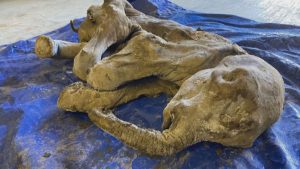The woolly mammoth baby unearthed in Yukon’s Klondike’s goldfields last year could be heading to Ottawa – temporarily.
Tr’ondëk Hwëch’in Government and Yukon government, which are working in partnership to care for the little mammoth, have applied to the Canadian Conservation Institute in Ottawa to have its body properly preserved.
The discovery of the prehistoric calf on June 21, 2022, affectionally named Nun Cho Ga – or big animal baby in the Hän language – attracted attention worldwide.
The young mammoth was discovered by placer miners at Eureka Creek near the community of Dawson City, located 530 km north of Whitehorse.
Scientists believe the animal to be between 30,000 to 35,000 years old. Thanks to thousands of years of permafrost freeze, Nun Cho Ga is the first intact baby mammoth found in North America and only the second complete baby mammoth in the world.
“We have much to learn from Nun Cho Ga,” said Debbie Nagano, heritage director for the First Nation at a Dec. 15 press conference. “It represents a tremendous moment in Tr’ondëk Hwëch’in’s timeless relationship with our ancestral lands and opportunity to reconnect with our traditions.”
Yukon government paleontologist Grant Zazula described Nun Cho Ga’s discovery as a dream come true.
“Last summer when that dream was realized, it really changed my life, not just as a scientist, but as a person,” he said. “The spirit of Nun Cho Ga has been so strong with all of us, and everyone who has worked with Nun Cho Ga has been deeply impacted.
“It’s done amazing things.”
Officials say plan for mammoth is in the works

The Canadian Conservation Institute promotes Canada’s heritage collections through its expertise in science, treatment and preventive conservation.
Zazula said the First Nation and Yukon government have met with the institute a number of times and are confident the application will be successful.
If approved, the animal would be transported from the walk-in freezer its currently being stored at in Dawson City to the institute where it would undergo freeze-drying.
Despite being a baby, Zazula said Nun Cho Ga is a large specimen and the process could take up to a year to complete.
Nagano said while there’s no official plan yet for the animal’s return, there are ongoing discussions about where it will be stored. That includes storing Nun Cho Ga at the First Nation’s new heritage complex which is currently under construction, expanding the community’s cultural centre or even storing it at the mining fields where it was discovered.
Read More:
‘She is one of our sacred ancestors’: Discovery of Nun cho ga a once-in-a-lifetime event
Skeleton unearthed by Yukon couple may be 10,000 years old
Zazula noted it was important Nun Cho Ga stay on the traditional territory on which it was discovered.
He said fossils of other ice age animals have been discovered in the Klondike region by miners dating back to the Gold Rush of 1898. Many of those fossils have since been sent to national collections or museums.
“The opportunity for people in the Dawson City community and the Tr’ondëk Hwëch’in, to actually have up and close experiences with Ice age animals isn’t really there,” he said.
He’s hopeful Nun Cho Ga will help spark change for Indigenous communities when it comes to the discovery of prehistoric animals.
“It’s a real process of reconciliation as well for communities that are finding these types of amazing animals from the ancient past to be able to have them in their community (and) to continue on relationships with those animals,” he said.
Nagano said after Nun Cho Ga is returned to Dawson City, it will not be displayed to the public.
“We want to do it in a respectful way. We don’t want to put (it) on exhibit,” she said.
‘Where’s the mother?’
Nun Cho Ga is not the first ancient animal to be discovered in permafrost-rich deposits in the Klondike region.
In recent years, an intact wolf pup named Zhùr, the remains of a caribou calf and a mummified squirrel were found by miners in the Klondike goldfields near Dawson City. All three animals are estimated to be tens-of-thousands of years old.
Zazula said melting permafrost, as well as warming temperatures due to climate change, could very well unearth more animals in the future.
“Even with finding the baby mammoth, there’s a connection to – where’s the mother? So, a lot of elders are questioning if we will be finding more,” Nagano said.
According to Zazula, Tr’ondëk Hwëch’in Elders have agreed to give permission for the animal’s DNA to be sampled, though that work has not yet started. The hope is for the genomic work to be done in Canada.
Zazula said since Nun Cho Ga’s discovery, there have been requests worldwide from bioscience companies to take samples of its DNA – all of which have been turned down.
Instead, any genetic information collected from the animal will be used to understand its relationship with other mammoths in Yukon and North America, as well as to place it in a family tree of North American and Beringian mammoths.
“We’re not doing de-extinction work,” Zazula said.
Nagano said the partnership should have an answer from the institute by the end of the month. If approved, a delegation of Elders, Tr’ondëk Hwëch’in representatives and government officials will accompany Nun Cho Ga on its journey to Ottawa.









